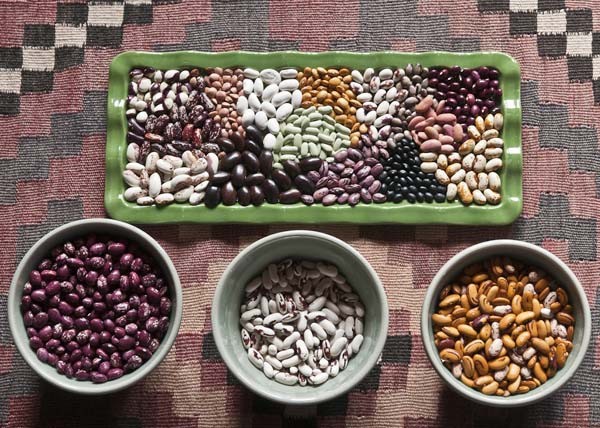Home gardeners like a challenge and will often go to great lengths to succeed with a particular vegetable or fruit. And they have great stories to tell about their on-going quests. Lopez gardener Carol Noyes is a perfect example. Beans are her story.
“Someone once told me many years ago, ‘You can’t grow dried beans on Lopez,’” Noyes told me recently. “At the time I was trying things like pinto and Jacob’s Cattle but they didn’t do well. Jacob’s Cattle did okay, but it’s not prolific.
Anyway, more recently I’ve thought, I like them so much there must be some that will mature on Lopez.” Noyes searched for dried beans that would ripen on Lopez. Her project, now moving into its second year, satisfies her desire to find beans that grow well here, but it’s also satisfies her passions for experimenting and learning and for collecting beans that are not only delicious to eat but aesthetically pleasing. Last year, Noyes planted 127 varieties of beans, mostly from New England, New Mexico or Europe. Imagine the logistics. She started in early May in four-inch pots in three batches, beginning with the pole and other long season beans. The seeds germinated quickly on a propagation mat and she transplanted them into a new garden spot where she hoped to improve the soil with this huge crop of beans.
“Originally I thought I was going to have a lot of beans,” she said. “By September I realized it had been a cold season and it was starting to rain and I was not going to get that many beans. I was a little disappointed for about five minutes, and then I realized this was a good test year. I’d really get a better idea of what would survive.” Ultimately she ended up with a little over a hundred varieties of dried beans. For good quality, early beans she recommends King of the Early, Ireland Creek Annie and Yellow Indian Woman. For black beans she recommends Black Coco and Hopi Black. For a white bean, she recommends Drabo. Sharing highlights of the rest of the trial, she said, “Lots of later-ripening varieties also did well despite the rain, like Montcalm Kidney, Soldier and French Navy.
A few that really got the mold, were Limelight, Great Northern, Pinto.” This year, Noyes is planting bean varieties from Europe, Southern Appalachia and Canada. Her planting strategies are the same, but this year’s bean candidates offer new possibilities and tastes.
“Both the European and Southern Appalachian cultures really like shelly beans, the fully formed bean that hasn’t dried in the pod yet. I’m not sure enough people know about shell or shelly beans,” she said, adding “I learned about them accidentally years ago when frost was threatening, the beans weren’t dry and I ate some. Get the word out there, they are wonderful.” She’s also interested in Runner Beans. “I think they’re great for the Northwest,” she said. “They’re tolerant of cold and they taste good as green, shell or dry beans. The British grow them though they are native to Central America.”
To find these seeds she researched online and used the Seed Savers Exchange Yearbook of forty-eight pages of bean listings. As we flipped through the pages, Noyes pointed out another pleasure of her bean study, the names of all these beans.
“The European beans have names like Zlatak and Uzice Speckled Wax. The Appalachian beans have names like Ma Williams and Tobacco Worm,” she said. “And there’s Cherokee Trail of Tears, a name and a bean that memorialize the forced relocation of Cherokee Indians in the mid-nineteenth century.”
As we admired the jewel-toned beans she spread out on the table, Noyes concluded, “Trialing is a useful thing. I do it personally because I like to learn things.” She encourages other gardeners to do the same, “Grow some things you can depend on but grow some new things too.”
For more bean information look for the folder titled Dried Beans for Lopez in the Reference Section of the Lopez library.




